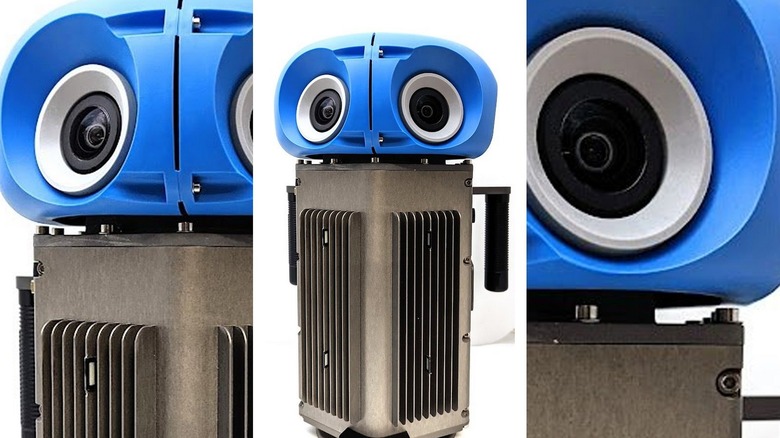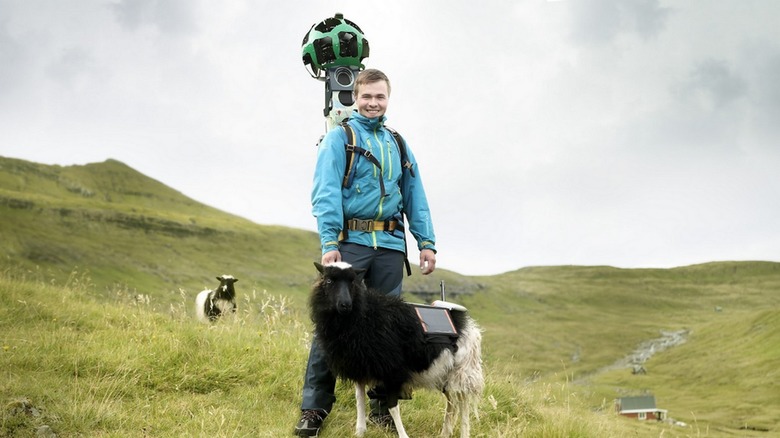Google Maps Has A New Street View Camera: Here's How To Spot It
One of the most interesting and useful Google Maps innovations is Street View, a system that allows users to see realistic 360-degree imagery of streets, buildings, and landmarks in all their real-world glory. Street View is now 15 years old, but it started as a research project at Stanford that employed Google co-founder and CEO Larry Page's car as the starting point for a global initiative.
At the heart of the photo-filled Street View are an array of specialized camera rigs. Google has all of its special Street View Ready camera specifications posted publicly for those that wish to replicate the design. But Street View is not just a method for taking a virtual tour of a place from the comfort of one's living room. It's also a time machine.
In the past few years, Google has made Street View into a system that offers a peek into the past. If you're using Street View with Google Maps on your desktop machine now, you can check for an icon of a clock in the upper right-hand corner of your screen to view historical imagery of that particular place or landmark. This functionality will also be available on mobile devices soon (if it's not already active by the time you read this article). In a nutshell, Google Maps Street View is a digital time capsule living in a mapping and navigation service.
A brief history of Street View
To mark its 15th anniversary, Google is giving a hardware boost to the Street View system and is also bringing some of its tricks to mobile. But for a project of this scale and worldwide impact, it is surprising to know that a bunch of Googlers used their extra time (from the company's famed "20% time" concept), to come up with the idea and execute it. Street View was approved internally in 2005, the same year Google Maps also made its way to the desktop.
When the Street View project first started, the team equipped a Chevy van with a bulky bundle that included a pair of laser scanners, a couple of high-speed video cameras, and eight high-res still cameras in a rosette configuration, all tethered to a rack of computers with 20 hard drives that captured imaging data at a speed of 20 MB per second.
But all that heft and bulk was not ideal for navigating crowded places and tight lanes, which prompted the team to build "lite" cars for Street View data collection. These were essentially barebones vehicles armed with low-res cameras connected to desktop PCs within.
Street View cameras in the wild
The next-gen Street View gear was fitted on a custom-hinged mast that had three laser scanners and could also retract the camera gear, allowing it to pass under bridges. This is the iteration that captured the majority of imaging data fed into Street View's current database.
One system of camera gear was equipped with eight cameras and a fish-eye lens on top, while another upped the number of camera sensors (CMOS sensors with an electronic rolling shutter) to 15 and nixed the fish-eye lens. Street View data was eventually enhanced with user-contributed imagery pulled from sources like Flickr.
But it was not just the camera hardware that kept getting refined. The camera-equipped Google Maps vehicles also got their fair share of tweaks. The Trike was a triple-wheel leg-drawn vehicle that covered a huge chunk of Street View data in urban and rural settings across the globe, while a snowmobile vehicle captured scenes around the 2010 Winter Olympics held in Vancouver. Oh, and camels have been used, too.
Welcome to the next generation
The next-gen Street View camera gear is shown at the head of this article, in case you want to keep an eye out and see one once they're in use. This new configuration is essentially an old-school Street View car system shrunk to the size of a house cat. Thanks to that compact form, which tips the scales at less than 15 pounds, this one can be carried with ease to a diverse range of locations. But the true gem here is the customizability aspect, as the modular system can be equipped with laser scanners when there's a need to collect more imaging data types.
Another convenience is that it can be mounted atop any car with a roof rack, which means there's no need for custom attachment gear. Plus, it can be controlled via a mobile device, which is another huge relief as it eliminates the need for high-end computing gear. Plus, the new camera gear will be covered in Google's signature splash of colors. The company is piloting the next-gen Street View hardware with plans to "fully roll it out" next year.
Google has no plans to retire the existing fleet of Street View cars and trekker bags, though. The company hopes that the smaller and lighter form factor, coupled with the flexibility aspect of its new Street View camera hardware, will open the doors for mapping more regions such as the Amazon jungles that have so far remained unexplored. Unfortunately, we don't have a name for this next-gen Street View camera hardware, even though it has an uncanny resemblance with the cute robot called Sqweeks in the Transformers film series.


